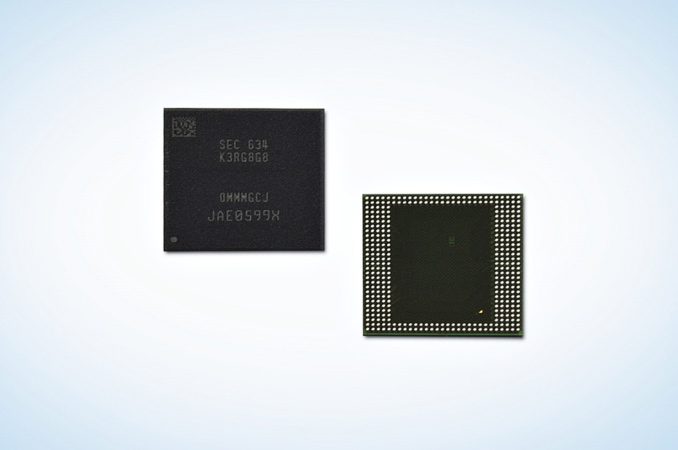Samsung Introduces 8 GB LPDDR4-4266 Package for Mobile Devices
by Anton Shilov on October 21, 2016 6:00 PM EST
Samsung this week announced its first LPDDR4 memory chips made using its 10nm-class DRAM fabrication technology. The new DRAM ICs feature the industry’s highest density of 16 Gb, are rated to run at 4266 MT/s data rate, and open the door to more mobile devices with 8 GB of DRAM.
Earlier this year Samsung started to produce DDR4 memory using its 10nm-class DRAM manufacturing process (which is believed to be 18 nm) and recently the firm began to use it to make LPDDR4 memory devices, just as it planned. The thinner fabrication technology allowed Samsung to increase capacity of a single LPDDR4 DRAM IC to 16 Gb (up from 12 Gb at 20nm introduced in August, 2015) while retaining a 4266 MT/s transfer rate.
The first product to use the 16 Gb ICs is Samsung’s 8 GB LPDDR4-4266 mobile DRAM package for smartphones, tablets, and other applications that can use LPDDR4. The device stacks four memory ICs and provides up to 34 GB/s of bandwidth when connected to an SoC using a 64-bit memory bus. The 8 GB DRAM package comes in a standard 15 mm x 15 mm x 1 mm form-factor, which is compatible with typical mobile devices, but Samsung can also make the package thinner than 1 mm to enable PoP stacking with a mobile application processor or a UFS NAND storage device.
| Samsung's 8 GB LPDDR4 DRAM Package | |||
| SEC 634 K3RG8G8 |
|||
| DRAM IC Capacity | 16 Gb | ||
| Number of DRAM ICs | 4 | ||
| Data Rate | 4266 MT/s | ||
| Bus Width | x64 | ||
| Bandwidth | 34 GB/s | ||
| Package | 15 mm x 15 mm x 1 mm | ||
| Process Technology | 10nm-class (18nm?) | ||
Samsung has not revealed a lot about the cost efficiency or power consumption of the 16 Gb LPDDR4 ICs, nor have they discussed those details for the 8 GB LPDDR4 package either. What little Samsung has said is that the latter consumes approximately the same amount of power as a 4 GB LPDDR4-3200 device (four 8 Gb ICs) made using its 20 nm-class process technology. Taken at face value, one can extrapolate that the switch to the 10nm-class fabrication process allowed Samsung to double the capacity and increase performance by 33% at the same power. Unfortunately, we do not know anything about the geometry scaling of the new ICs relative to Samsung's older ICs, so it's hard to even guess how much Samsung's newest DDR4 costs to fab.
Samsung has not officially commented on when it plans to start commercial shipments of its 8 GB LPDDR4 packages, but it is reasonable to assume that the company will commence sales of such devices in the coming months, with actual products hitting the market in 2017.
Source: Samsung










40 Comments
View All Comments
ddriver - Saturday, October 22, 2016 - link
It is not nonsense, DDR4266 is indeed listed to have 1133 MHz clock, and it works for all cases, because that's what "double" means - multiplied by 2https://en.wikipedia.org/wiki/Mobile_DDR
ddriver - Saturday, October 22, 2016 - link
Typo - 2133 MHzRocket321 - Monday, October 24, 2016 - link
Link to Newegg selling ddr4 4266? No I agree with the others, I do not think those sticks exist. It is not 2133 ram being talked about here.It seems that somehow mobile ram has significantly outpaced desktop ram speeds.
wolfemane - Tuesday, October 25, 2016 - link
maybe you need to look harderhttp://www.newegg.com/Product/Product.aspx?Item=N8...
wolfemane - Tuesday, October 25, 2016 - link
and anotherhttp://www.newegg.com/Product/Product.aspx?Item=N8...
wolfemane - Tuesday, October 25, 2016 - link
oh SNAP! and anotherhttp://www.newegg.com/Product/Product.aspx?Item=N8...
Rocket321 - Wednesday, November 2, 2016 - link
wolfemane - you win! I didn't realize there were DDR4 sticks running that fast.nandnandnand - Tuesday, October 25, 2016 - link
From the source: "The new 8GB LPDDR4 operates at up to 4,266 megabits per second (Mbps), which is twice as fast as DDR4 DRAM for PCs working typically at 2,133 Mbps per pin. Assuming a 64 bit (x64) wide memory bus, this can be viewed as transmitting over 34GBs of data per second."ZeDestructor - Friday, October 21, 2016 - link
Trace length, mostly. With the really, really short distances of PoP packging, you can crank the speeds a fair bit higher and then have the internals arranged differently to not need very different DRAM cells.danjw - Saturday, October 22, 2016 - link
The frequency of the bus is half the rating, it is reading/writing twice for each clock: https://en.wikipedia.org/wiki/Mobile_DDR . Hence, Double Data Rate (DDR).